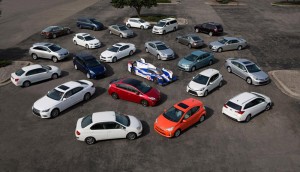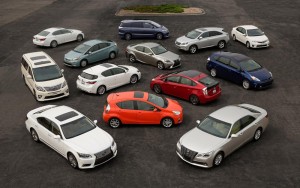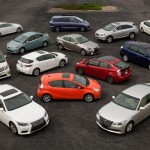Want to save money and fuel? Toyota plans to help consumers do both.
Promising continued gains in fuel economy, Toyota Motor Corporation (TMC) Managing Officer Satoshi Ogiso outlined the launch of a new era in hybrid technology with the arrival of the next-generation Prius, while Toyota Motor Sales (TMS) Senior Vice President of Sales Bob Carter issued a challenge for the industry to significantly step up its commitment to hybrids as a core technology.

As a backdrop to these announcements, Toyota gathered in one place for the first time ever the entire Toyota and Lexus global hybrid line up. The company has sold more than 5 million Toyota and Lexus hybrids worldwide. The environmental effect has been an estimated 34 million ton reduction in C02 — the equivalent of taking 4.8 million vehicles off the road.
“I would like to see us — as an industry — accomplish the same thing in the U.S.,”
Said Carter,
“That is…5 million hybrids, cumulatively, in the U.S. by close of business 2016. That results in 3 billion gallons of fuel saved, which is more than enough fuel for the entire population of the United States to drive from San Francisco to Los Angeles in a Prius. It’s do-able. And I think we will do it.”
Stressing Toyota’s further commitment to industry hybrid leadership, Ogiso announced that,
“When the next generation Prius arrives, it will begin a new era for a broad range of Toyota and Lexus vehicles.”
and will be
“The first to introduce a substantially improved family of hybrid powertrains.”
Between now and the end of 2015, Toyota plans to introduce 15 new or redesigned hybrid vehicles globally. These new hybrid powertrains will deliver significantly improved fuel economy in a more compact package that is lighter in weight and lower in cost. Ogiso said the performance of this new generation of powertrains will reflect significant advances in battery, electric motor and petrol engine technologies that are part of Toyota’s larger strategy towards the electrification of the automobile through hybrid, battery electric and fuel cell technologies.
Ogiso used the next-generation Prius as an example,
“The current Prius has held America’s fuel economy crown for many years. In its three generations, Prius MPG has improved on average by about 10 percent, each generation. The challenge to continue to improve at this rate — to beat your own record — becomes very difficult, but makes it all the more motivating. We are very motivated to beat our record.”

The next Prius will feature improved batteries with higher energy density – the relationship between the battery’s output and dimensions. Toyota, already a leader in advanced drive battery technology, has stepped up its research, development and production capacity of both nickel-metal hydride and lithium-ion and will use these technologies where appropriate in its expanding focus on electrification of the automobile. Toyota has also ramped up development on new battery technologies like solid state and lithium air, as well as devoting resources focused on chemistries beyond lithium, such as magnesium and other low-valence materials.
The next Prius will also feature electric motors that will be smaller in size. He noted that the current Prius motors have four times the power density of the first model and that, “the next will be even higher.”
In addition, the thermal efficiency of the petrol engine in the current Prius is 38.5 percent. The next-generation will boost that level to more than 40 percent – a world best.
The next Prius will also utilize Toyota New Global Architecture (TNGA), featuring a lower center of gravity and increased structural rigidity, which will contribute to greatly improved driving dynamics.
Improved aerodynamics will contribute to an all-new exterior design. Ogiso promised a roomier interior and significant refinements in design, layout and ease of operation.
Ogiso also said the next-generation Prius Plug-in (PHV) is being developed in parallel with the standard Prius model.
“We have been listening very carefully to Prius PHV owners and are considering their requests for additional all-electric range. We have also heard from owners that they would like a more convenient charging operation. In response, we are developing a new wireless/inductive charging system that produces resonance between an on-floor coil and an onboard coil to transmit power to the battery, providing charging without the fuss of a cable.”
He said verification work on the system will be conducted in Japan, the U.S. and Europe in 2014.
Work is also progressing on Toyota’s first commercially available hydrogen fuel cell vehicle, a new mid-size four-door sedan whose concept will be unveiled at the Tokyo Motor Show in November. That vehicle will make its North American debut in January at the 2014 Consumer Electronics Show in Las Vegas, where Bob Carter will discuss the role of Toyota’s U.S.-based engineering team in its development, as well as preliminary plans for introduction into the U.S. market.
Carter said that the hydrogen fuel cell will utilize core hybrid technology and will be a primary element of Toyota’s future mobility strategy. Bob Carter added,
“Toyota currently accounts for more than 60 percent of U.S. hybrid sales and 70 percent of the nearly 3 million hybrids on U.S. roads today. Over the past 5 years, the percentage of hybrid sales at Toyota has grown from 10 to 16 percent of our total sales mix. Honda is less than 2% and Ford is less than 3%. And while hybrid as a percentage of the total market is just under 4 percent, we believe that it can…and must grow.”
Source; Toyota


